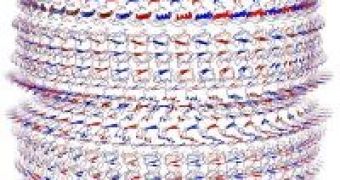Science goes deeper into the cellular universe. A team at UCLA's California NanoSystems Institute, the David Geffen School of Medicine at UCLA and the Howard Hughes Medical Institute has come with a new research published in the peer-reviewed, open-access journal PLoS Biology the structure of the largest cellular particle ever crystallized, an achievement that could improve drug delivery through nanomaterial artificial vaults imitating the natural models.
Vaults are big, barrel-shaped formations encountered in the cytoplasm (fluid part) of all mammalian cells, being involved in innate immunity. Nanoscale capsules could imitate their function, functioning as therapeutic delivery vehicles.
The new research comes with a proposed atomic structure for the thin outer layer of the vault, achieved through the application of X-ray diffraction and computer modeling. The draft atomic model corresponds to the main vault protein, wrapping the vault like a shell.
"Our draft model is essentially an atomic-level vault with a completely unique structure, like a barrel with staves. It is unlike any other large structure found in nature. The outside of the vault structure is like an eggshell - a continuous protective barrier with no gaps." said co-author Leonard H. Rome of the departments of biological chemistry at the Geffen School of Medicine and the California NanoSystems Institute.
The shell comprises 96 identical protein molecules, each containing 873 amino acids and folded into 14 areas. Each molecule presents a large stave in the middle of the vault.
"These nanostructured vaults offer a human-friendly nanocontainer, like a molecular-level C-5A transport jet, with a cargo hold large enough to encompass a whole ribosome with its hundreds of proteins and nucleic acids, or enough drugs to control a cell," said lead researcher David Eisenberg of the departments of biological chemistry at the Geffen School of Medicine and the California NanoSystems Institute members of the Howard Hughes Medical Institute and the UCLA-U.S. Department of Energy Institute for Genomics and Proteomics.

 14 DAY TRIAL //
14 DAY TRIAL //